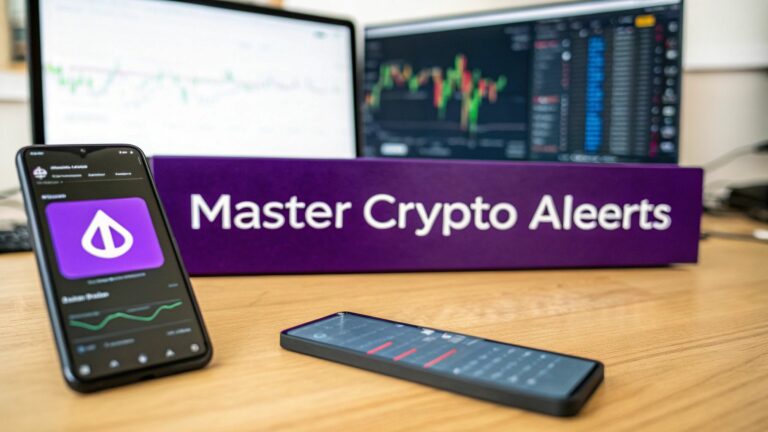Let’s be honest: trying to manually track the 24/7 crypto market is a fool's errand. You simply can't watch the charts all day, every day. Price alerts are the tools that let you step away from the screen without missing a critical move. Think of them as your personal market watchdog, always on guard.
Why Crypto Price Alerts Are Non-Negotiable
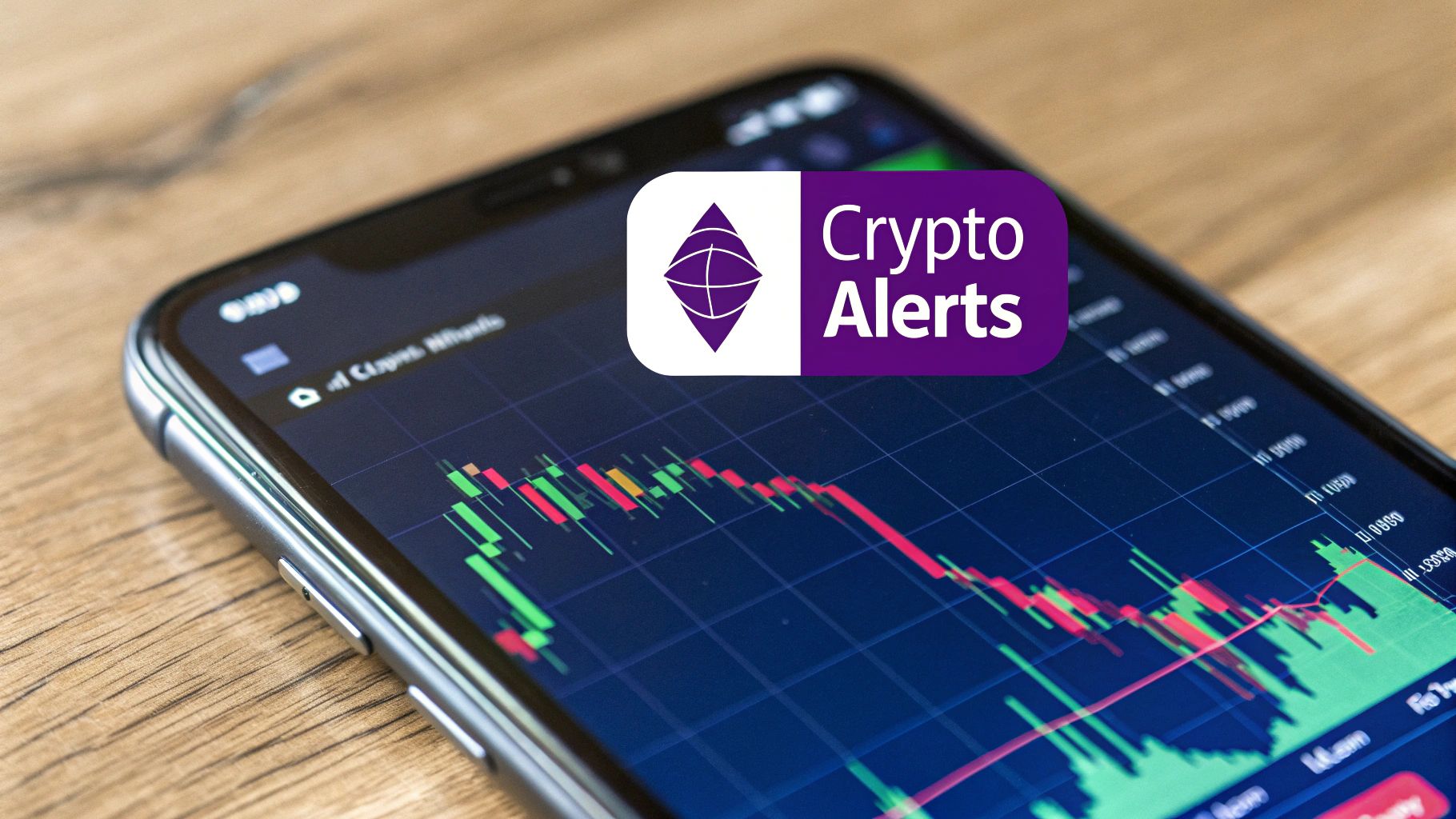
The cost of being offline—even just for a few hours—can be staggering. You could miss a major pump that defines your entire month or a dump that wipes out your gains.
We’ve all heard the stories. A trader steps away for the weekend, only to come back and see their target asset has surged 30%. Without an automated alert, that opportunity is just gone. This isn't some rare occurrence; it's a painful reality in a market that never sleeps.
Transform from Observer to Proactive Trader
Volatility is the lifeblood of crypto. It’s a double-edged sword that creates both risk and immense opportunity. The key is being ready to act the second those opportunities pop up. This is where vTrader’s crypto price alerts completely change the game. They shift you from being a passive screen-watcher to a proactive trader, ready to execute your plan instantly.
History makes a powerful case for this. Remember when Bitcoin shot up from around $800 in late 2016 to nearly $20,000 by December 2017? Or when it crashed back down to about $3,100 a year later? You can dig into these massive swings over at CoinMarketCap. Those are the kinds of moves where a timely notification isn't just helpful—it's essential.
The vTrader dashboard gives you a clean overview where you can monitor everything at a glance and set up these critical alerts.

From here, it's easy to see which coins need your attention and where you should set your next alert thresholds.
The True Cost of Inaction
Relying on luck or constant manual checks is a losing strategy in this game. The most successful traders I know don't just have a plan; they have systems in place that execute that plan for them.
An alert isn't just a notification; it's a call to action. It’s the trigger that puts your trading strategy into motion, ensuring you never have to say, "If only I had known sooner."
When you set up alerts in vTrader, you're building both a safety net and an opportunity engine. You can go live your life, confident that you won't miss the next big thing. If you want to build a stronger foundation in these trading concepts, check out the in-depth guides in the https://www.vtrader.io/en-us/academy.
Setting Your First vTrader Alert in Minutes
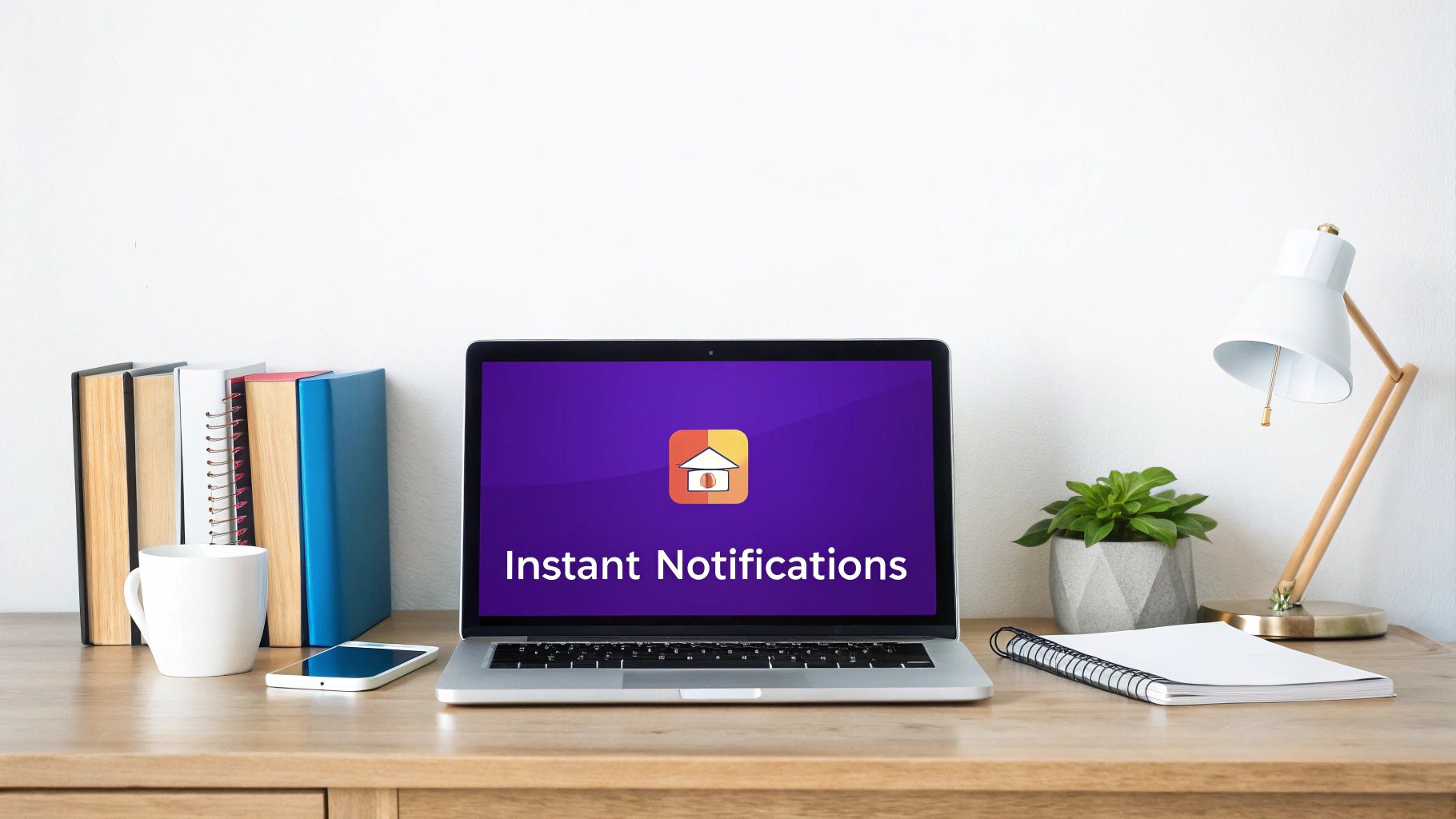
Let's cut through the theory and get something working right now. The fastest way to see how powerful vTrader can be is to set up your first alert. It takes just a couple of minutes, and once it's done, you'll have an automated watchdog for your portfolio.
We'll use a classic trading scenario. Say you've got your eye on Ethereum. You've done your homework and believe $3,500 is a major resistance level. You want an instant heads-up the moment it punches through that price, so you can decide your next move without being glued to the charts.
How to Create Your Notification
First thing you’ll notice in the vTrader dashboard is the big ‘Create New Alert’ button. It’s right there, impossible to miss. No hunting through menus.
Clicking it pops up a clean, simple window where you'll tell the system exactly what to look for. This is where your trading plan gets real.

This little dialog box is your command center. Everything you need is right here.
Go ahead and start typing "ETH" or "Ethereum" into the asset field; the platform will find it for you instantly. If you need a quick refresher on the coin, you can dive into its detailed profile and charts on https://www.vtrader.io/en-us/currency/eth.
Next, you define the trigger. It’s a simple, three-part instruction:
- Condition: Select "Price".
- Trigger: Choose "Rises Above".
- Value: Type in "3500".
That's it. You've just told vTrader, "Let me know the second ETH crosses above $3,500."
Choosing Your Alert Method
The final piece of the puzzle is deciding how you want to get the news. For a critical price breakout like this, you want something you can't ignore. A push notification sent straight to your phone is usually the best bet. It guarantees you get the signal the moment it happens, whether you’re at your desk or on the move.
My personal take: For make-or-break price levels—like a major resistance breach or a stop-loss trigger—I always use a push notification combined with a custom sound. It helps me instantly separate the "must-see-now" alerts from the "good-to-know" ones.
While we're talking crypto here, understanding the general principles of setting up alerts is a skill that pays off across any trading platform.
Hit 'Create Alert,' and you're done. Your first automated monitor is live. You've officially shifted from passively watching the market to actively engaging it with a pre-set plan.
Using Advanced Alerts for Smarter Trading
Let's be honest, a simple "price hits X" alert is useful, but it’s just scratching the surface. That’s where you start. But to really gain an edge, you need to graduate to alerts that monitor the market’s behavior, not just its price.
This is how you start thinking like a pro trader. You stop just reacting and start anticipating, using the full power of vTrader to find high-quality, actionable signals. Let’s dive into some of the more powerful options that can give you a real advantage.
Monitoring Momentum with Percentage Change
Instead of pinning your hopes on a static price target, start tracking momentum. A Percentage Change alert is perfect for this. Picture this: you're eyeing a volatile asset and want to catch a significant dip to buy in. If the asset is in a strong uptrend, setting an alert for a specific price might mean you miss the boat entirely.
A much smarter play is to set an alert like: "Notify me if Solana drops 10% within a one-hour window." This kind of alert is dynamic. It doesn't care if the price is $150 or $180; a sudden 10% plunge is a major event that signals a potential entry for anyone looking to buy the dip. If you want to get a better handle on how assets like Solana typically move, you can find a deep-dive analysis of its market trends right here on vTrader.
Spotting Breakouts with Volume Spikes
Price movement alone only tells you half the story. A price jump on low volume can easily be a fakeout, but a price surge backed by a massive spike in trading volume? That often signals a genuine, sustainable breakout. This is precisely where Volume Spike alerts become your best friend.
You can set up a vTrader alert to fire only when two conditions are met:
- An asset’s price smashes through a key resistance level.
- The trading volume is 200% higher than its 24-hour average.
An alert like this is a game-changer. It filters out all the insignificant price wiggles and ensures you’re only notified when there’s real conviction behind a move. It's the difference between chasing shadows and acting on confirmed market strength.
The vTrader platform makes layering these conditions surprisingly simple, letting you build custom alerts that fit your exact strategy.
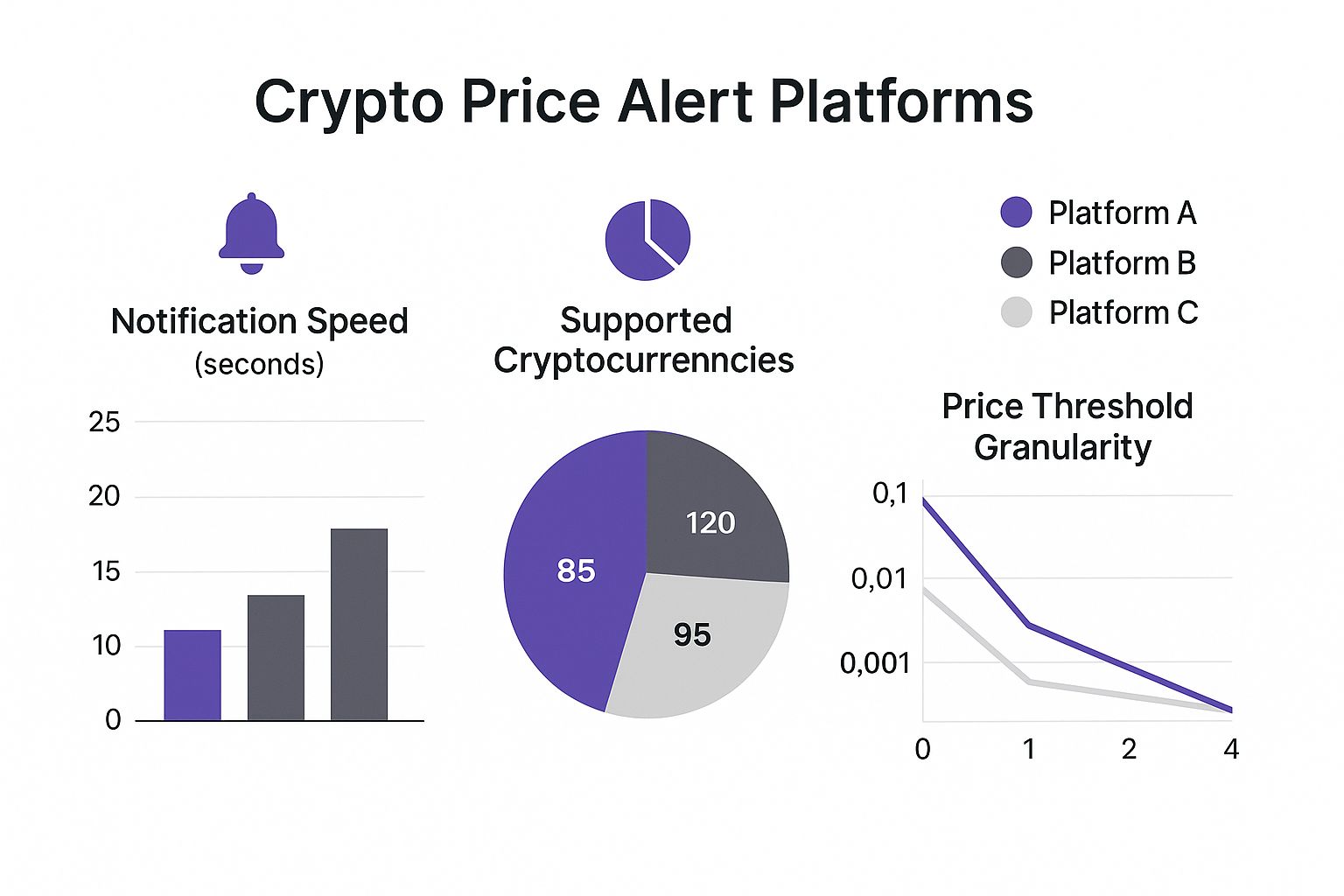
As you can see, the interface is designed to let you stack different conditions to create a truly bespoke alert that fits your specific trading plan.
To help you decide which tool is right for the job, this table breaks down the advanced alert types and shows the ideal trading scenario for each.
Choosing the Right vTrader Alert for Your Strategy
| Alert Type | Best Used For | Example Scenario |
|---|---|---|
| Percentage Change | Catching sudden momentum shifts and volatility. | Notifying you if BTC drops 5% in 1 hour to signal a potential dip-buying opportunity. |
| Volume Spike | Confirming the strength of a price breakout or breakdown. | Alerting you when ETH breaks $4,000 and volume is 150% above the daily average. |
| MA Crossover | Identifying major trend reversals for longer-term trades. | Triggering a notification the moment the 50-day moving average crosses above the 200-day MA (a "golden cross"). |
Matching the alert to your strategy is key. A day trader focused on volatility will rely on percentage and volume alerts, while a swing trader might focus more on moving average crossovers to confirm longer-term trend changes.
Confirming Trends with Technical Indicators
For anyone who leans on technical analysis, vTrader's indicator-based alerts are indispensable. One of the most powerful and widely used is the Moving Average (MA) Crossover alert.
A "golden cross"—when a short-term moving average (like the 50-day) crosses above a long-term one (like the 200-day)—is a classic bullish signal. But trying to watch for this manually across dozens of charts is nearly impossible.
With vTrader, you just automate it. Set an alert to trigger the second a golden cross happens on any coin in your watchlist. This gives you automated confirmation of a potential trend reversal, so you can enter a trade with confidence, knowing it's backed by a time-tested technical signal.
Ultimately, these advanced crypto price alerts are about working smarter, not harder. They let you build a sophisticated monitoring system that feeds you high-probability trading opportunities, freeing you from having to stare at the charts all day.
How to Avoid Alert Fatigue and Stay Focused
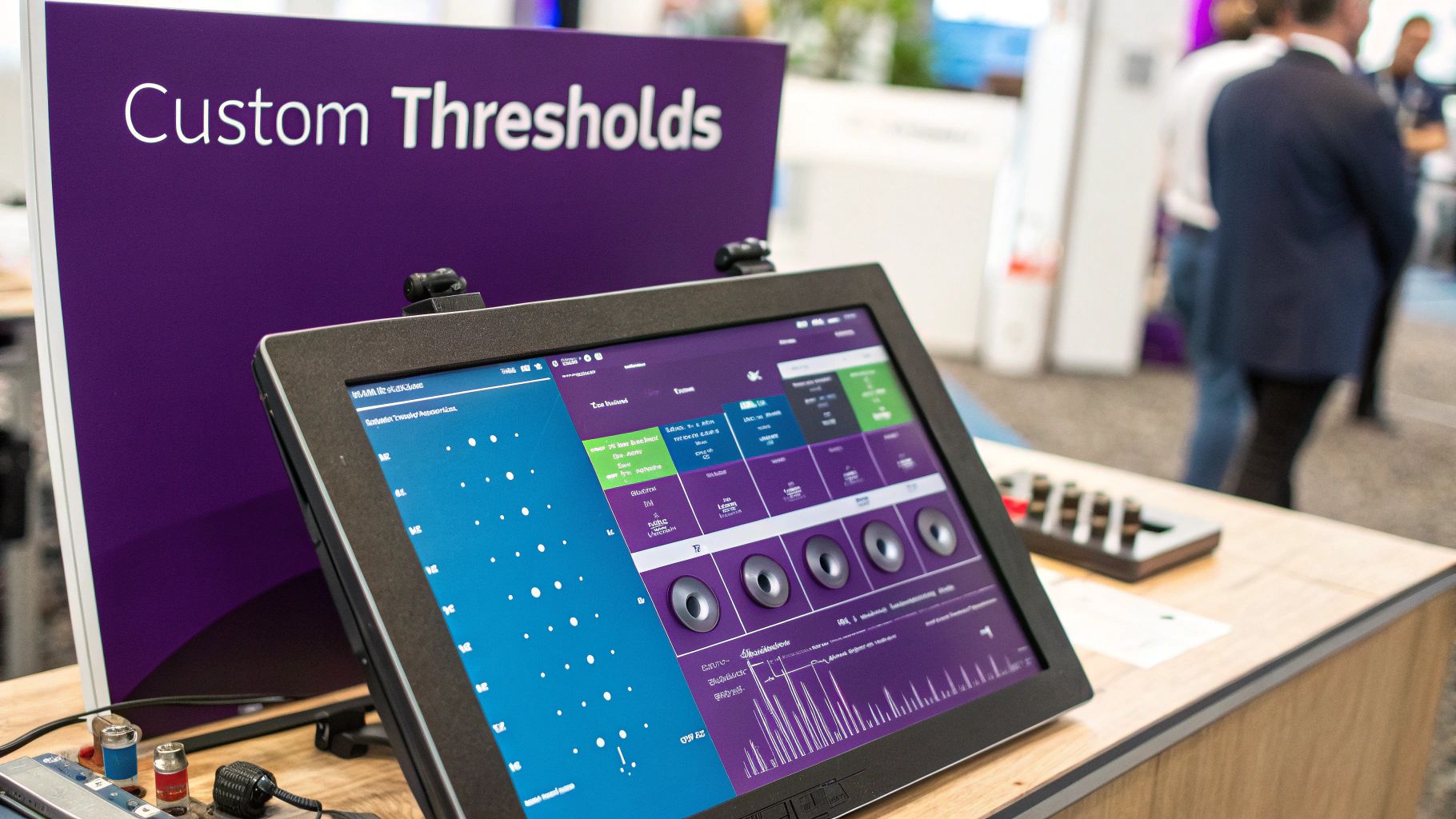
Let's be real—getting too many crypto alerts is just as useless as getting none. It’s a constant buzz that quickly turns into background noise, making you tune out the very signals that could make or break a trade. This is alert fatigue, and frankly, it's a trader's worst enemy.
The answer isn't just switching everything off. It's about being smarter, refining your strategy until every single notification is something you actually need to see. This means moving past random numbers and setting alerts that genuinely matter. It's all about quality, not quantity.
Set Alerts Based on Technical Levels
First things first: stop setting alerts at arbitrary price points. If your alerts are based on gut feelings, you're doing it wrong. Instead, you need to anchor every alert to significant technical levels you've identified through proper analysis.
Look at your charts. Base your alerts on established support and resistance zones, key Fibonacci levels, or major psychological numbers where the price has reacted before. An alert triggered at a historically proven resistance level is infinitely more powerful than one set at a random price that just "felt" important.
Use Conditional Logic to Filter False Alarms
This is where a powerful tool like vTrader really flexes its muscles. A simple price target can get triggered by every minor wick and fakeout. To fight this, you need to build smarter alerts using conditional logic.
Instead of a basic "tell me when Bitcoin hits $65,000," you can create something much more robust:
- Condition 1: Price moves above $65,000.
- AND Condition 2: Trading volume spikes 150% above its 24-hour average.
This two-part alert filters out all the low-conviction drifts and only pings you when a breakout has real momentum behind it. You're no longer reacting to market bluffs. This kind of precision is only possible with immense data processing in the background. Think about it—top-tier data providers like CoinDesk Data are tracking tick-level updates for over 10,000 coins. In a market where assets can swing 10% in a day, that data is everything.
My Personal Tip: The Weekly Alert Audit
I do this every Sunday without fail. I take 15 minutes to review every active alert in my vTrader dashboard. For each one, I ask a simple question: "Was this useful this week, or was it just noise?" If an alert was firing off constantly on tiny moves or didn't trigger at all on a major one, I either kill it or tweak its conditions. This simple habit keeps my entire alert system clean, effective, and trustworthy.
Cull Underperforming Notifications
Treat your alerts like they're employees. If one of them isn't doing its job, you have to let it go. You need to be absolutely ruthless about culling alerts that are outdated or just not performing.
Did you set an alert for a trade idea that’s no longer valid? Delete it. Have an alert for a low-cap altcoin that’s constantly going off because of its natural volatility? Either tighten its rules or get rid of it.
By constantly cleaning up your crypto price alerts, you build a system you can actually trust. You’ll get to a point where a vTrader notification makes you sit up and pay attention, because you know it means something. That level of focus is what separates traders who are consistently profitable from those who are just perpetually distracted.
Integrating Alerts into Your Daily Trading Routine
Getting a crypto price alert is just the first domino. That ping on your phone is a signal, nothing more. How you react—or don't react—is what ultimately decides whether you walk away with a profit or a loss.
Building a solid workflow around your vTrader notifications is what separates the pros from the amateurs. It’s all about turning those signals into swift, confident actions, free from the panic or FOMO that wrecks so many accounts. An alert that just gets buried in your phone's notification feed is worthless. You have to make the important signals impossible to ignore.
Channeling Alerts for Maximum Impact
If you’re a trader who’s always on the go, piping your vTrader alerts directly into a service like Telegram can be a game-changer. It gives you a clean, dedicated channel just for your trade signals, far away from the noise of group chats and email spam.
Here’s another pro tip I swear by: use custom notification sounds. Set a specific, satisfying "cha-ching" sound for when a take-profit target gets hit. For a critical stop-loss alert, use something more urgent and jarring. This kind of auditory cue tells you the priority of the alert before you even glance at your screen.
A well-structured alert system doesn't just inform you; it prepares you. It provides the right information, at the right time, through the right channel, giving you the mental space to execute your plan calmly and effectively.
Creating Your Personal Response Protocol
The most disciplined traders I know all have one thing in common: they operate with a clear plan for every contingency. This is your response protocol, and it’s the absolute backbone of a successful trading system. It’s just a pre-written set of rules you create for yourself that spells out exactly what you will do when a specific alert fires.
Think of it like a pilot's checklist. For instance:
- Take-Profit Alert (BTC breaks $70,000): If this alert triggers, your protocol might be: "Sell 50% of the position now. Move the stop-loss on the remaining 50% up to my original entry point." You can use our in-depth Bitcoin currency page to find the key levels to inform these decisions.
- Stop-Loss Warning (ETH drops to $3,250): Your rule could be: "Instantly check market volume and recent news headlines. If there's heavy volume on a red candle and bad news, close the entire position. If volume is low, wait 15 minutes to see if it’s just a shakeout before acting."
This structure takes the guesswork and emotion completely out of the equation. When an alert hits, you’re not scrambling or second-guessing. You’re simply executing a plan you made when you were calm and rational.
While these alerts are fantastic for automating specific trading tasks, it's also worth looking into broader general financial automation strategies to streamline other areas of your financial life. By building these kinds of systems, you turn simple crypto price alerts from being just notifications into the trigger for a disciplined, repeatable, and successful trading routine.
Got Questions About Crypto Price Alerts? We've Got Answers
Even with the best strategy, you're bound to have some questions as you start leaning on crypto price alerts. It’s totally normal. Let's walk through some of the most common things traders ask, so you can start using vTrader with the confidence of a pro.
It helps to remember what’s at stake here. In 2024, the global crypto market cap ballooned to around $3.44 trillion, with Bitcoin itself making up a massive $2.17 trillion of that. When a 1% swing in BTC's price can shift the market by over $21 billion and daily volumes are hitting nearly $99 billion, you can see why real-time notifications are so critical. You can watch these numbers move live on CoinMarketCap.
Understanding the environment you're trading in helps you set smarter alerts. Getting familiar with the broader crypto sector gives you the context needed to move beyond simple price targets and build a real strategy.
How Are vTrader Alerts Different from My Exchange’s Alerts?
This is a big one, and a question I hear all the time. The short answer is: they’re not even in the same league.
Most alerts you get from an exchange are pretty basic. They can tell you if a coin hits a certain price, but that’s about it. They offer no context, no confirmation, and no real intelligence.
vTrader, on the other hand, lets you build sophisticated, multi-layered alerts. You can combine price action with other critical data points that real traders use, like:
- Volume Spikes: Is that price jump real or a fakeout? An alert that requires a surge in trading volume helps you tell the difference.
- Percentage Changes: Instead of chasing a static number, you can track real momentum and volatility as the market moves.
- Technical Indicators: Forget staring at charts all day. You can automate alerts for key signals, like a Moving Average crossover that might signal a trend is about to reverse.
It's the difference between a simple doorbell and a full-blown security system. One tells you someone's there; the other tells you who it is and what they're doing.
Here’s a pro tip I give to everyone: Set your stop-loss alert to trigger before your actual stop-loss order on the exchange. If your hard stop is at $50,000, set a vTrader alert for $50,500. That early warning gives you a moment to breathe, check the charts, and decide if you want to let the trade close or adjust your plan. It’s saved me more than once.
What if I Have More Questions?
Of course you will! Building a great alert system is a constant process of tweaking and refining. As you gain more experience, your questions will get more specific to your personal trading style.
We’ve seen it all, and we've put together a huge resource to help you out. If you ever get stuck or just want to dig deeper into a specific feature, explore our comprehensive FAQ page. It’s packed with answers.
https://www.vtrader.io/en-us/faq
Ready to stop missing moves and start trading with an edge? Join vTrader today and get access to zero-fee trading, these powerful crypto price alerts, and a whole suite of tools built to make you a sharper trader. Sign up now and get a $10 bonus to kickstart your portfolio!

Steve Gregory is a lawyer in the United States who specializes in licensing for cryptocurrency companies and products. Steve began his career as an attorney in 2015 but made the switch to working in cryptocurrency full time shortly after joining the original team at Gemini Trust Company, an early cryptocurrency exchange based in New York City. Steve then joined CEX.io and was able to launch their regulated US-based cryptocurrency. Steve then went on to become the CEO at currency.com when he ran for four years and was able to lead currency.com to being fully acquired in 2025.
